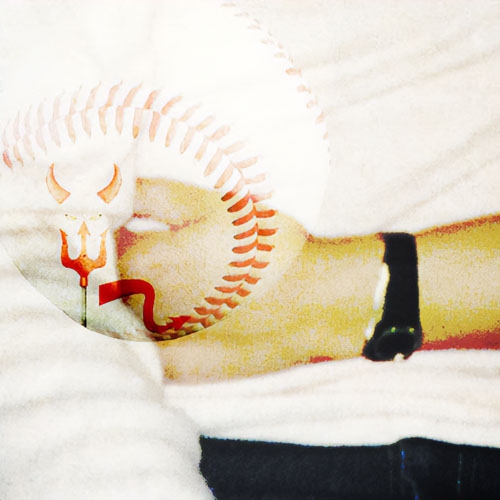Between 1962 and 1970 we destroyed 6 million acres of Vietnamese forest, using the most deadly manmade substance known. Today, thousands of the 2 million American soldiers who were exposed to this poison are living under sentence of death.
Orange Was the New ICK!
or Paul Reutershan, the Vietnam War did not end until last December. But before succumbing to cancer, the twenty-seven-year-old former army sergeant sparked what is becoming an international drama, publicly accusing Dow Chemical and the United States government of his own murder. Reutershan was convinced that his cancer had stemmed from his repeated exposure to Agent Orange, the Dow-manufactured defoliant employed by U.S. troops in Vietnam.
Paul Reutershan’s 1977 Labor Day weekend was interrupted by what he thought was a case of food poisoning. After he experienced sharp abdominal pains, he checked into a Norwalk, Conn., hospital; two months later tests taken there revealed widespread abdominal cancer. Tumors proliferated outside of Paul’s colon; since two were attached to the main artery, the cancer was inoperable. Doctors gave him only a few days to live.
But Paul rallied, and by March he was back at his job as a Conrail commuter train conductor.
One morning rush-hour run, Paul was explaining his long absence to a passenger, detailing his suspicions about Agent Orange’s contributions to the disease. The passenger, a cable-television talk show producer, offered to book Paul for an interview. A publicity campaign was quickly put together, as thousands of veterans contacted Paul, saying that they were experiencing similar symptoms. Paul advanced to the guest’s chair on national radio and television shows. This was his message: ’’Agent Orange is killing me, and it’s probably going to kill every person who came into contact with it in Vietnam.”
In 1968, at age seventeen, Paul had enlisted in hopes of learning skills that would land him a well-paying job after his discharge. Having been trained as an airplane mechanic, he came home to the 1970’s escalation of layoffs in that industry and was unemployed for more than a year. When Conrail hired him as a conductor, he told his friends that he felt especially lucky. The pay was good. He enjoyed his work, and company benefits were generous. But the benefits stopped when Paul was no longer able to work. He died owing more than $40,000 in medical bills.
Agent Orange was the code name for a defoliant sprayed to eliminate dense Vietnamese jungle cover. A cynical Defense Department dubbed the project “Operation Hades,” and between 1962 and 1970, repeated spraying of the chemical had covered a total of close to 6 million acres of South Vietnam. A synthetic growth hormone, Agent Orange sent plants off on a wildly careening, cancerous growth spree. Soon they would explode; their remains lay limp and exhausted. Carcasses of two-foot-long bananas, weeds tree-sized and grotesquely misshapen, and mangrove trees bowed down by their own weight would rot, quietly surrealistic in the sweet-and-foul-smelling mist. Those once exotic Vietnamese jungles could now be the set for a hallucinatory, doom-prophesying horror film. Soldiers mocked the natives’ refusal to venture into what they called, with canny prescience, “the land of the dead.”
Agent Orange is a mixture of two chemicals; one, trichlorophenoxyacetic acid (2.4,5-T). of which half of the mixture is made up, contains minute amounts of an inevitable contaminant by-product. dioxin. Called “the most toxic man-made substance known” by Dr. Barry Commoner, outspoken science critic and the director of the Center for the Biology of Natural Systems at Washington University, dioxin is so potent a killer that just three ounces of it placed in New York City’s water supply could wipe out the populace. In laboratory studies conducted in the early 1960’s. dioxin began to emerge as a fetus-deformer 1 million times as potent as thalidomide, and also as a potential carcinogen. And an estimated 130 pounds of dioxin were loosed on South Vietnam before 1970, when well-publicized pressure from environmentalists forced the United States government to cut back on its repeated Operation Hades blitzes.
“They had to spray it as punishment detail,” says the wife of one victim. “Their eyes would be tearing.”
Many veterans don’t know whether or not they came into contact with Agent Orange during their time in Southeast Asia. But recent evidence shows that the dioxin contaminant in the chemical makes a stealthy journey through air, food. and water, insidiously creeping into the body tissue even when the victim is not directly exposed.
Peter Lablance was stationed in Vinh Long, in the Mekong Delta, in 1968 and 1969. “I would say it was a heavily sprayed area, but I don’t know,” he says. “I got hold of the VA people in Chicago, but they wouldn’t tell me anything about it.”
Peter is now exhibiting symptoms that are classic results of dioxin exposure: “Since I got out of the service, I’ve had a very bad stomach; right now I can’t keep any food down I just can’t eat. I’ve had tests run, but the doctors can’t classify what I have. I’ve got terrible chest pains. My hands and feet turn white sometimes; they don’t stay white — it’s off and on. I don’t know if it’s symptoms of that stuff or not. But it scares me enough to want to try to find out.”
Commoner thinks that dioxin accumulates in body fat, where it may remain undetected for years When weight is lost, the fat breaks down and dioxin is sent into the bloodstream. The victim falls prey to irrational emotional outbursts; hands and feet become numb; an acne-like rash often covers the entire body. And there are sharp, shooting stomach pains.
“It now appears that dioxin may be a kind of toxicologic time bomb,” Commoner says, “and that people exposed to it may exhibit harmful symptoms [which] appear only many years later.” That is cheerless news for the nearly 2 million Americans who abetted the Agent Orange campaign, not to mention the Vietnamese people against whom it was perpetrated.
Veterans are caught in the crossfire of a battle that has been raging for years. At the Geneva Convention the United States was the only participant to refuse to sign a treaty forbidding biological, chemical, or germ warfare. And the U.S. fought to keep herbicides classified as defoliants, rather than as a form of chemical warfare. For the VA to distribute Agent Orange-related disability benefits would be tantamount to admitting that the government had been wrong — if not lying — when it assured troops that the defoliants they were spraying were not harmful to human or animal life.
Veterans are afraid that if word leaks out that they’re experiencing symptoms of dioxin exposure, their jobs and personal lives may be jeopardized.
“They’re caught between the rock and the hard place,” says John Upton, director of health services for the National Alliance of Concerned Veterans, when asked why most veterans won’t discuss their symptoms with reporters. “They’ve been hearing about dioxin — and they’re scared. But they’ve already been burned. They’re afraid to come forward; they don’t know if their private lives can take the repercussions.”
John has been contacted by thousands of veterans requesting that he provide them information on Agent Orange. “But they don’t want me to give out their names — not to the VA — not to anybody.”
When Paul Reutershan went on. “The Today Show,” Jane Pauley was skeptical about his “hunch” that Agent Orange had caused his cancer. It seemed to Paul that she was accusing him of trying to stick the VA.
“I’ve let everybody down.” he told his sister, Jane Dziedzich, after the show “Now the public will think we’re just out for the money.”
Jane now heads up Agent Orange Victims International, an organization Paul founded to reverse government. Dow, and VA disavowal of responsibility for veterans’ Agent Orange-exposure symptoms. “He knew he wouldn’t live to see them admit that he was right,” says Jane. “But he couldn’t stand knowing that other guys would take the same crap he’d gotten — and that they’d die without even knowing what hit them.”
Paul had to give up his apartment; he moved in with Jane until he went into the hospital for the last time. His CB-rigged Datsun is perched in her driveway; she points out his two dogs, which have made sawdust out of her front porch. The wood-paneled living room sports a profusion of pictures of a smiling, uniformed Paul; crucifixes dangle over doorways. Jane’s five-year-old son plays with a train he got for Christmas, and he tells anyone who will listen about the time his uncle took him for a ride on the Conrail. And in the kitchen letters from worried veterans spill out of file cabinets. A bulletin board keeps Jane apprised of what’s happening with the most serious cases; index cards list when and where the men were in Vietnam and are crosshatched and filed when she hears that they’ve died.
When a barely perceptible fifty parts dioxin per trillion is put in the diets of monkeys, the effects on them can be lethal, according to studies conducted by Dr. James Allen, a professor of pathology at the University of Wisconsin’s Medical School. And while it’s impossible to judge precisely how much dioxin crept into the tissues of soldiers and civilians in Vietnam, it’s now thought that the quantity was great enough to guarantee devastating repercussions. “The air force admits to having as high as forty-nine parts per million dioxin in Agent Orange,” Dr. Allen reports. Unofficial sources estimate that the levels sometimes were much higher. As one chemical company official admits: “It’s hard to tell during wartime, because manufacturers come and go.”
A nine-month exposure to dioxin caused a 50 percent mortality rate in Dr. Allen’s monkey test group. “There’s a malabsorption of the nutrients. [The monkeys] continue to eat well; yet they lose a lot of weight and become malnourished. There are hemorrhages all over the body. What happens, basically, is that they bleed and starve to death.”
Desperate for sustenance for its reckless, unhinged growth, the body consumes itself.
“There is no question that many of the symptoms are similar to those recorded in humans.” Dr. Allen states. “We cannot say that the same thing that occurs in monkeys will occur in man. But [the study] does give us good leads for what we should be looking for. We found reproductive failures in monkeys after six months with just fifty parts dioxin per trillion. We should be cognizant of this and look for low-level exposure in the human population. There are suggestions of cancer; we found it with rats, and certainly we should start looking for it in Vietnam veterans.”
Paul Steinke, a law student, is convinced that he was one of the Agent Orange guinea pigs. “And as far as I know, I’m the only vet on the West Coast with a pending claim for Agent Orange disability benefits.”
Paul was a helicopter pilot for the 101st Airborne Division at Camp Eagle, in South Vietnam’s northeastern sector. He estimates that he spent between 20 and 60 hours flying time in spraying Agent Orange. He reports that the 701st just released a statement to the VA that the division’s helicopters had never disseminated defoliants.
C-123 and C-130 cargo planes were used for Operation Hades’s massive defoliation jobs. Helicopters were used for the delicate. close-in work. “We sprayed when the area was near friendly hamlets,” Steinke says.
The helicopters flew without cargo doors so that frequent ground fire could be returned. The rotary blades would kick up what Paul describes as “little tornadoes” of spray into the men’s faces. Paul knows that he got a good, strong dose.
“The cockpit was full of fumes,” he says. “The stuff smelled sickly sweet; it was dank, like, mold. I’ve never smelled anything like it.”
Despite the fetid fumes, the men were told not to wear masks. “Command insisted that the spray wasn’t harmful to any animal or human life, although we were told not to spill any on our fingers or hands, because it would burn like acid. And we had to use old, beat-up planes. because it peeled the paint off.”
Paul’s description of defoliated areas indicates that Agent Orange harmed more than foliage. “There was no animal or insect life; the land was dull and dirty and gray — and it was dead. The jungle looked like a little pond near where I used to live that had been flooded for a number of years. The trees were bent over, dying; it was a desolate, dead place.”
Now, nearly nine years after his discharge, Paul has been diagnosed as having partial parasthesia (a partial numbness in his fingers and toes). His wife has had four miscarriages. Paul tries to stay forty pounds over what his weight should be; he finds that when he’s thinner, he is subject to irrational emotional outbursts. He is convinced that Agent Orange figures in his ailments.
But Paul’s symptoms are mild compared with some that have been reported. Abdominal cancer has killed a disproportionate number of Vietnam veterans. Their wives have had trouble conceiving and then with carrying children to term; when a pregnancy is completed, there is a heightened risk of delivering a deformed or retarded child.
“When I got out of the service, I experienced severe emotional trauma. I attributed it to the war,” Paul says now ’’I’d had to play John Wayne over there. I didn’t think I had mental problems — I just figured it was a reaction to being in the war and doing what I was doing. I’d take live bodies out to the field; I’d bring dead bodies back from the field. We all went a little crazy over there. We knew it was a crazy war.”
Paul tried to minimize his problems. Until he saw a Chicago television station’s one-hour documentary on Agent Orange, he had assumed that his symptoms were isolated. “I hadn’t really confided in anybody. I figured it was just something that I had to live with, and that I’d grow out of it.”
Now, he admits, he feels betrayal and rage. “Why didn’t they at least give us minimal safeguards?” And there’s a more immediate question: When will the U.S. government acknowledge its obligations to those whom it subjected to dioxin in Vietnam?
After seeing government studies conducted during Agent Orange’s Vietnamese reign, Barry Commoner found that even then government research had turned up substantial evidence that dioxin remained active in the environment for at least fourteen years.
Now dioxin has surfaced in America’s backyard. Information emanating from Niagara Falls’ Love Canal indicates that dioxin remains toxic for up to thirty years. This evidence is a powerful contradiction of results of tests funded and run by Dow Chemical, which “prove” that dioxin is photosynthetic (destroyed by the sun) and biodegradable.
The Love Canal dump was a repository for wastes from the Hooker Chemical and Plastics Company between 1947 and 1953. Experts calculate that 141 pounds of dioxin are in the canal’s groundwater (they expect to find 2,000 pounds stored elsewhere in the county}, a result of Hooker’s dumping trichlorophenol, a not-so-distant relative of 2,4,5-T, into their devil’s brew.
Hooker unloaded the Love Canal waste site in 1953. selling it to the Niagara Falls Board of Education for a dollar — and a contract absolving the company of any responsibility for problems that could arise later from the chemicals stored there.
On “The Today Show,” a Hooker vice-president said that “years ago many companies weren’t aware of the hazards” of burying chemical wastes. But Dr. Robert Mobbs, a Boston physician active in pesticides control, says that Hooker “damn well knew” just how dangerous its wastes were. In 1948, Mobbs had conducted tests that showed that one of Hooker’s chemicals dumped in the canal had caused tumors in rabbits. Mobbs presented his evidence in testimony before Congress.
In August 1978, residents were evacuated from the contaminated Love Canal area. No epidemiological study has been conducted, but the New York Health Department reports that there was an increase of birth abnormalities, an increase in the frequency of cancer among residents. and an unusual number of reports of emphysema, skin rashes, and respiratory ailments. One resident told a reporter last December, “We’ve lost six or seven cats. They get down by the stream, and it starts — eating the skin and the fur off their feet. Then they die a few days later.” No resident could recall a neighborhood pet that had lived to be more than three years old.
A July 10, 1976, explosion at Seveso’s Givaudan chemical plant in Italy sent up a cloud of trichlorophenol (the same compound present in the Love Canal) along with from two to eleven pounds of its companion chemical, dioxin. Birds dropped from the sky; pets fell dead.
Residents of the industrial suburb, thirteen miles north of Milan, were evacuated, many suffering from nausea, dizziness, and chloracne. Residents have developed lung and nervous-system disorders; some report suffering stomach pains.
Attempts at cleanup were nearly impossible. The area was cordoned off; thousands of tons of dioxin-contaminated topsoil was hosed down to prevent the wind from spreading it. The topsoil was soon bagged — but nobody could agree on a way to dispose of it. Incineration was suggested, but Seveso residents — many uncomfortably relocated in nearby hotels and housing projects — almost rioted to prevent the ascension of a second toxic cloud. Then officials decided to dump the cache far out in the ocean. That solution was rejected because of the cost and because it wouldn’t destroy the contaminant. An abandoned West German mine was suggested and then rejected. So, bags containing 200,000 tons of contaminated topsoil are stored in a Seveso school building along with bags containing the carcasses of 81,000 domestic animals.
The outside walls of houses in the contaminated area were resurfaced. and residents began to move back last fall. But traces of dioxin are still cropping up — some as far as twenty miles away.
Scientists in government and industry did not begin conducting comprehensive studies on the toxicity of herbicides until 1962, when Rachel Carson’s The Silent Spring signaled a public alert. There are, however, reports dating back to 1949 that hint at the dangerous side effects induced by dioxin.
Once the lid had been pried off their Pandora’s box, however, officials moved quickly. By 1969, the Health. Education, and Welfare Department’s National Cancer Institute (NCI) was hushing up findings on the toxicity of dioxin.
In 1964 it had commissioned the Bionetics Research Laboratory in Bethesda, Md., to study the teratogenic (fetus-deforming) and carcinogenic effects of widely used pesticides on laboratory animals. The resultant report confirmed dioxin’s toxicity — on both counts.
But the findings were not passed on to FDA officials until 1968. During the four-year interim, its contents were privy only to officials in the Defense and Agriculture departments.
The NCI finally released the report’s car-cinogenicity findings in 1969. Omitted from the release was information on dioxin’s fetus-deforming properties.
An infuriated FDA employee slipped a copy of the unedited report to one of Ralph Nader’s Raiders. The ensuing publicity forced the government by 1970 to discontinue widespread spraying of Agent Orange in Vietnam.
According to one former White House staffer, the full disclosure oi the bionetics report would have fueled the growing anti-war movement and also would have contributed to international criticism of American chemical warfare. FDA officials claimed that chemical companies had applied pressures that kept the agency from disclosing its findings.
Just before the 95th Congress adjourned, a one-day hearing on Agent Orange was held before the House Committee on Veterans’ Affairs. “The hearing was a whitewash,” says Sandy Horowitz, aide to Illinois Rep. Abner Mikva, who pressed for the session. “It was ridiculous. No veterans were asked to appear, let alone academics who have done studies suggesting that there could be a harmful health consequence of exposure to Agent Orange.”
“We don’t have any one single response at this point,” Gary Jones, who spearheads public relations for Dow’s Ag-Organics Department, said when asked at the time this article was being written what Dow’s response was to the charges being brought against dioxin. “The larger problem is the ubiquity of dioxins, and we don’t know whether it’s a problem or not. We don’t know what it means to human health.”
Jones explains that dioxin is present in such minute amounts in 2,4,5-T that looking for it “is like analyzing a river when you’re looking for a grain of sand.” He dismisses the dioxin problem: “One-part dioxin per trillion means one inch for 16 million miles of 2,4,5-T.”
But subtract the zeros, and suddenly Jones is saying that one-part dioxin per million means one inch of dioxin in sixteen miles of 2,4,5-T The dioxin ratio in Agent Orange’s 2,4,5-T went as high as forty-nine parts per million. If three ounces can kill 8 million people, the dioxin ratio in Agent Orange is far from insignificant.
But Jones counters this as well: “We’ve searched for dioxin in 2,4,5-T, and we have not found it.”
(If Dow is not looking very hard, others are. In March of this year, the Environmental Protection Agency ordered a temporary, emergency ban of 2,4,5-T. Dow denounced the ban and went to court to have it overturned. At the time this is written, all that can be said with any certainty is that the controversy will continue in the courts for some time.)
“I’m convinced now that there is a link,” says Bill Kurtis, anchorman and executive producer of an investigative reporting unit for a CBS-affiliate station in Chicago. Last year, Kurtis and his staff put together a documentary on dioxin — and on Agent Orange’s role in its dissemination — that convinced Paul Steinke that others shared his problem.
“Frankly, I had filed away the herbicide problem as no story,” says Kurtis, whose years of experience as a CBS foreign correspondent show in his careful and deliberate selection of facts, words, facial expressions, and vocal resonances. “Even though people tried to make a story of it, there was no contact. There was no human case to throw up.”
A claims counselor for the Chicago VA changed that. Maude De Victor noticed an unusual number of claims and queries coming through her inbox; they listed births of deformed children and symptoms ranging from abdominal cancer to uncontrollable anger and numbness in the fingers and toes. A vet’s wife telephoned De Victor, crying; her husband was dying of cancer and the VA had denied benefits, disavowing any connection between his illness and his service in Vietnam. But the woman told De Victor, her husband kept insisting, “It’s those chemicals from Vietnam.”
De Victor contacted the assistant to the air force surgeon general, who confirmed her suspicion that these apparently unrelated symptoms could stem from a common cause — exposure to Operation Hades’ herbicides.
The VA encouraged De Victor to begin gathering data on the Agent Orange connection; but soon the VA countermanded its orders. She was then transferred to another area, where she no longer would come into contact with the veterans. And she was told unequivocally that she must drop her search. She complied with the order, but she sent a detailed outline of her suspicions to Kurtis.
“It just hit me between the eyes like no other story,” Kurtis says now. “She had listed her research material, as well as four or five conclusions about what this would mean if, in fact, these men were having problems.”
There was no digging for this story, Kurtis admits. All of its pieces were there, waiting to be put together. “We farmed out across the country. And as we got into it, the whole thing became clear.
“When you talk to a guy whose child doesn’t have any fingers, it’s very graphic and convincing, but it’s just one side of the story Then you go to Globe, Arizona [where heavy spraying of 2,4,5-T is administered for crop control], and it’s something you almost can’t read about. You see ducks with horribly deformed wings. In Oregon you hear people complaining of suspected exposure to 2,4,5-T.”
Kurtis admits that he was skeptical about the reports. As he explained: “All of these people had the reputations, within their communities and with the establishment they were fighting, of being kooks. But all of a sudden all of the kooks in all of the stories sounded identical.
“If it hadn’t been for the veterans, though, I really don’t know how long it would have been before the story came out. The veterans provide the link; they bring the emotion.”
The pathos and irony and the drama of the exploding dioxin time bomb were expressed poignantly by Paul Reutershan shortly before he went into the hospital for the last time: “I died in Vietnam and didn’t even know it.”

























